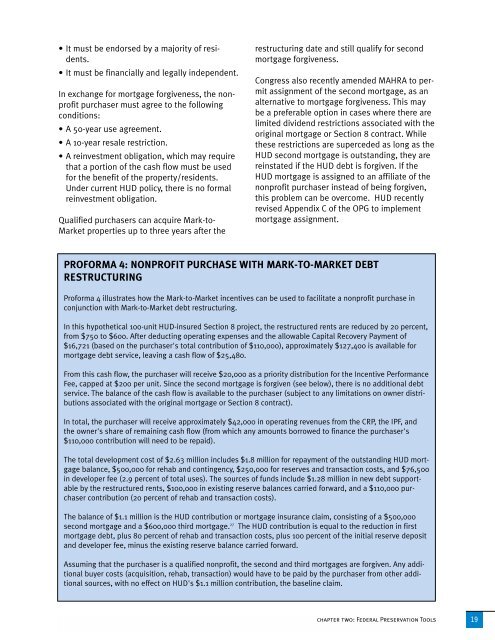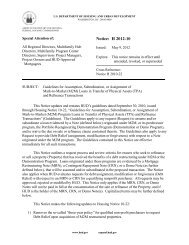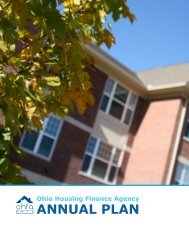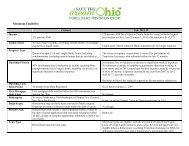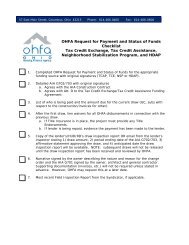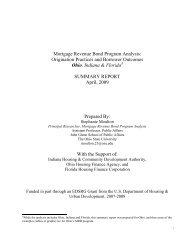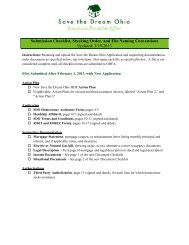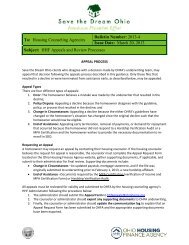lis 217 stemming the tide - LISC
lis 217 stemming the tide - LISC
lis 217 stemming the tide - LISC
- No tags were found...
You also want an ePaper? Increase the reach of your titles
YUMPU automatically turns print PDFs into web optimized ePapers that Google loves.
• It must be endorsed by a majority of residents.• It must be financially and legally independent.In exchange for mortgage forgiveness, <strong>the</strong> nonprofitpurchaser must agree to <strong>the</strong> followingconditions:• A 50-year use agreement.• A 10-year resale restriction.• A reinvestment obligation, which may requirethat a portion of <strong>the</strong> cash flow must be usedfor <strong>the</strong> benefit of <strong>the</strong> property/residents.Under current HUD policy, <strong>the</strong>re is no formalreinvestment obligation.Qualified purchasers can acquire Mark-to-Market properties up to three years after <strong>the</strong>restructuring date and still qualify for secondmortgage forgiveness.Congress also recently amended MAHRA to permitassignment of <strong>the</strong> second mortgage, as analternative to mortgage forgiveness. This maybe a preferable option in cases where <strong>the</strong>re arelimited dividend restrictions associated with <strong>the</strong>original mortgage or Section 8 contract. While<strong>the</strong>se restrictions are superceded as long as <strong>the</strong>HUD second mortgage is outstanding, <strong>the</strong>y arereinstated if <strong>the</strong> HUD debt is forgiven. If <strong>the</strong>HUD mortgage is assigned to an affiliate of <strong>the</strong>nonprofit purchaser instead of being forgiven,this problem can be overcome. HUD recentlyrevised Appendix C of <strong>the</strong> OPG to implementmortgage assignment.PROFORMA 4: NONPROFIT PURCHASE WITH MARK-TO-MARKET DEBTRESTRUCTURINGProforma 4 illustrates how <strong>the</strong> Mark-to-Market incentives can be used to facilitate a nonprofit purchase inconjunction with Mark-to-Market debt restructuring.In this hypo<strong>the</strong>tical 100-unit HUD-insured Section 8 project, <strong>the</strong> restructured rents are reduced by 20 percent,from $750 to $600. After deducting operating expenses and <strong>the</strong> allowable Capital Recovery Payment of$16,721 (based on <strong>the</strong> purchaser's total contribution of $110,000), approximately $127,400 is available formortgage debt service, leaving a cash flow of $25,480.From this cash flow, <strong>the</strong> purchaser will receive $20,000 as a priority distribution for <strong>the</strong> Incentive PerformanceFee, capped at $200 per unit. Since <strong>the</strong> second mortgage is forgiven (see below), <strong>the</strong>re is no additional debtservice. The balance of <strong>the</strong> cash flow is available to <strong>the</strong> purchaser (subject to any limitations on owner distributionsassociated with <strong>the</strong> original mortgage or Section 8 contract).In total, <strong>the</strong> purchaser will receive approximately $42,000 in operating revenues from <strong>the</strong> CRP, <strong>the</strong> IPF, and<strong>the</strong> owner's share of remaining cash flow (from which any amounts borrowed to finance <strong>the</strong> purchaser's$110,000 contribution will need to be repaid).The total development cost of $2.63 million includes $1.8 million for repayment of <strong>the</strong> outstanding HUD mortgagebalance, $500,000 for rehab and contingency, $250,000 for reserves and transaction costs, and $76,500in developer fee (2.9 percent of total uses). The sources of funds include $1.28 million in new debt supportableby <strong>the</strong> restructured rents, $100,000 in existing reserve balances carried forward, and a $110,000 purchasercontribution (20 percent of rehab and transaction costs).The balance of $1.1 million is <strong>the</strong> HUD contribution or mortgage insurance claim, consisting of a $500,000second mortgage and a $600,000 third mortgage. 27 The HUD contribution is equal to <strong>the</strong> reduction in firstmortgage debt, plus 80 percent of rehab and transaction costs, plus 100 percent of <strong>the</strong> initial reserve depositand developer fee, minus <strong>the</strong> existing reserve balance carried forward.Assuming that <strong>the</strong> purchaser is a qualified nonprofit, <strong>the</strong> second and third mortgages are forgiven. Any additionalbuyer costs (acquisition, rehab, transaction) would have to be paid by <strong>the</strong> purchaser from o<strong>the</strong>r additionalsources, with no effect on HUD's $1.1 million contribution, <strong>the</strong> baseline claim.chapter two: Federal Preservation Tools19


